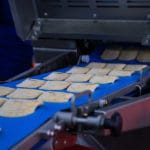- Food Industry Executive
- Posts
- Increasing Competitiveness Through Automation in the Food Industry
Increasing Competitiveness Through Automation in the Food Industry

By Jeff Conner, Dallas Service Manager for Control Concepts
In the food industry, where margins are slim, automation continues to make inroads in efforts to increase competitiveness through improved efficiency, productivity, and cost savings. Like other manufacturing industries, the food industry has been slow to adopt automation. But as wages remain stagnant, the effort to provide the same food without raising prices keeps food processors hopping.
Automation is one of the top food manufacturing trends for 2019, as reported by Food Engineering Magazine. In a recent poll, 22% of those responding reported installing advanced automation systems.
The benefits of automation in the food industry illustrate the reasons why executives see upgrading their systems as such an important way to increase competitiveness.
The benefits of automation in the food industry
The food industry covers a broad swath of businesses, from farms to restaurants and grocery stores. Automation now touches almost every facet of food processing in some way, and with labor expenses rising and the labor market tightening, the industry looks to improvements in robotics, computing, and sensors to pick up the slack.
Automation means precision, which improves and maintains compliance with government regulations. Decreasing and eliminating fines is a huge cost saver.
Profit margins are small. Improved productivity and efficiency stretches those margins a little further.
Automating production lines can make them more flexible, able to retool and adapt quickly to changing needs.
Becoming a more efficient part of the supply chain can be a differentiator.
As it has with the automotive and other manufacturing industries, automation has proven key to growing any food-related business. Customer desires change constantly, and business executives must find streamlined ways to meet evolving demands. As labor becomes more scarce and food industry workers start taking other jobs, automation can fill roles that previously sat empty, preventing damage to customer experience and profits.
Where do you find automation in the food industry?
Automation can be found in every phase of food harvesting, processing, preparation, and transportation.
Fast food restaurants leverage automation to create efficiency and improve productivity for everything from flipping hamburgers to frying chicken. Older automation merely helped workers by alerting them for cook times and temperatures. Improvements in robotics and sensors have made it possible to use machinery to take over more of the manual labor.
Innovations like smart ovens can combine several appliances like a convection oven, dehydrator, air fryer, warming drawer, broiler, slow cooker, and toaster. Smart ovens can even have cameras inside for monitoring food as well as remote activation and even automatic temperature setting based on what’s placed inside of it.
Food processing plants and warehouses are using more automatic guided vehicles for transporting raw materials and finished products in place of forklifts. These vehicles have reduced product damage and reinforced workforce discipline.
Modern food processing and packaging continues to add automated ovens, cutting and forming machines, mixers and blenders, sorting equipment, filling and wrapping equipment, and other machinery to the assembly line. Instead of sitting at the line, workers stay in a control room to ensure everything continues to flow smoothly, make modifications in processes, and troubleshoot problems.
Even grocery stores are getting into the game, using automated machinery to pick and fill e-commerce orders in their warehouses.
Considerations for selecting automation
Hygienic design and strategic inventory planning are two areas to keep top of mind when selecting automation in food manufacturing.
Meeting USDA and FSIS safeguards require machinery with specific characteristics such as impervious surface finishes, non-corrosive parts, no cracks or crevices, toxin-free materials, and high durability. Everything from conveyor belts to stuffers must maintain hygienic standards.
Going back to the ever-shifting consumer, the ability to implement lightweight and flexible technology can help determine inventory needs without shortages or excess materials.
Automation in the food industry increases competitiveness by eliminating errors and waste, improving efficiency and productivity, and expanding profit margins. Cost savings can be diverted to R&D and other business improvements. Businesses can keep up with regulatory changes with less effort, decrease labor costs, and eliminate injury.
With over 25 years of experience in the industrial automation repair industry, Jeff Conner is the Dallas Service Manager for Control Concepts and serves on the Advisory Committee for the Electronics Technologies Department at Texas State Technical College. Control Concepts has extensive experience with automated food and beverage processing and has helped design, fabricate, install, test, and program control systems for the industry.
Control Concepts understands automated food and beverage processing and stands ready to help design, fabricate, install, test, and program control systems. We also provide emergency retrofit services to replace obsolete equipment, save energy, and reduce maintenance downtime. We service almost any brand of control found in automated systems and can send an experienced technician anywhere one is needed 24 hours a day, 7 days a week.